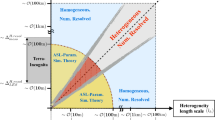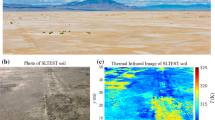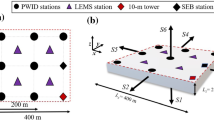Abstract
Representing land–atmosphere exchange processes at the ground surface of numerical-weather-prediction models remains a challenge in spite of the recent advances in computing. Previous studies investigating the effects of spatial surface heterogeneities have been viewed from a turbulence perspective, mostly assuming the existence of a blending length scale above which surface-induced perturbations are modelled using an ad hoc bulk surface parameter representing a pseudo-equivalent surface condition. While these types of approaches can generate reasonable results, they fail to account for the long-lasting spatial perturbations that modify the mean flow. In this work, the interactions between the characteristic scales of surface thermal heterogeneities and the mean resolved fluid dynamics are investigated for a broad range of unstable atmospheric conditions. Thermal dispersive fluxes, which naturally appear as a means to account for persistent-in-time advection fluxes generated by unresolved spatial heterogeneities, provide a quantification of the interaction between surface thermal heterogeneities and the atmospheric boundary-layer mean flow. Hence, they also provide a deterministic approach for including the effect of unresolved processes on the mean flow. We introduce a new non-dimensional number (i.e., the heterogeneity parameter) that can be used to identify the flow conditions and surface configurations in which heterogeneity effects become important. The heterogeneity parameter can be used to distinguish cases with high and low dispersive-flux contributions based on the mean flow and characteristics of the thermal heterogeneities. These results suggest that under weak geostrophic forcing, surface heterogeneity effects should be accounted for in numerical-weather-prediction models.











Similar content being viewed by others
References
Albertson JD, Parlange MB (1999) Surface length scales and shear stress: implications for land-atmospheric interaction over complex terrain. Water Resour Res 35(7):2121–2132
Basu S, Lacser A (2017) A cautionary note on the use of Monin–Obukhov similarity theory in very high-resolution large-eddy simulations. Boundary-Layer Meteorol 163(2):351–355
Bennett LJ, Weckwerth TM, Blyth AM, Geerts B, Miao Q, Richardson YP (2010) Observations of the evolution of the nocturnal and convective boundary layers and the structure of open-celled convection on 14 June 2002. Mon Weather Rev 138(7):2589–2607
Bou-Zeid E, Meneveau C, Parlange MB (2004) Large-eddy simulation of neutral atmospheric boundary layer flow over heterogeneous surfaces: blending height and effective surface roughness. Water Resour Res 40(2):1–18
Bou-Zeid E, Meneveau C, Parlange MB (2005) A scale-dependent Lagrangian dynamic model for large eddy simulation of complex turbulent flows. Phys Fluids 17(2):025,105
Brutsaert W (1982) Evaporation into the atmosphere. Springer, Dordrecht
Brutsaert W, Parlange MB, Gash JHC (1989) Neutral humidity profiles in the boundary layer and regional evaporation from sparse pine forest. Ann Geophys 7:623–630
Calaf M, Meneveau C, Parlange MB (2011) Large-eddy simulation study of a fully developed thermal wind-turbine array boundary layer. In: Kuerten H, Geurts B, Armenio V, Fröhlich J (eds) Direct and large-eddy simulation VIII, ERCOFTAC series, vol 15. Springer, Dordrecht, pp 239–244
Canuto C, Hussaini MY, Quarteroni A, Zang TA (1988) Spectral methods in fluid dynamics. Springer, Berlin
Chorin AJ (1968) Numerical solution of the Navier–Stokes equations. Math Comput 22:745–762
Hultmark M, Calaf M, Parlange MB (2013) A new wall shear stress model for atmospheric boundary layer simulations. J Atmos Sci 70(11):3460–3470
Inagaki A, Letzel MO, Raasch S, Kanda M (2006) Impact of surface heterogeneity on energy imbalance: a study using LES. J Meteorol Soc Jpn 84(1):187–198
Kanda M, Inagaki A, Letzel MO, Raasch S, Watanabe T (2004) LES study of the energy imbalance problem with eddy covariance fluxes. Boundary-Layer Meteorol 110(3):381–404
Konrad TG (1970) The dynamics of the convective process in clear air as seen by radar. J Atmos Sci 27(8):1138–1147
Kravchenko AG, Moin P (1997) On the effect of numerical errors in large eddy simulations of turbulent flows. J Comput Phys 131(2):310–322
Li N, Laizet S (2010) 2DECOMP & FFT—a highly scalable 2D decomposition library and FFT interface. In: Cray User Group 2010 conference, pp 1–13
Margairaz F, Giometto MG, Parlange MB, Calaf M (2018) Comparison of dealiasing schemes in large-eddy simulation of neutrally stratified atmospheric flows. Geosci Model Dev 11(10):4069–4084
Margairaz F, Pardyjak E, Calaf M (2020) Surface thermal heterogeneities and the atmospheric boundary layer: the relevance of dispersive fluxes. Boundary-Layer Meteorol 175:369–395
Mauder M, Desjardins RL, Pattey E, Gao Z, van Haarlem R (2008) Measurement of the sensible eddy heat flux based on spatial averaging of continuous ground-based observations. Boundary-Layer Meteorol 128(1):151–172
Moeng CH (1984) A large-eddy-simulation model for the study of planetary boundary-layer turbulence. J Atmos Sci 41(13):2052–2062
Monin AS, Obukhov AM (1954) Basic laws of turbulent mixing in the surface layer of the atmosphere. Proc Geophys Inst Natl Acad Sci USSR 24(151):163–187
Patton EG, Sullivan PP, Moeng CH (2005) The influence of idealized heterogeneity on wet and dry planetary boundary layers coupled to the land surface. J Atmos Sci 62(7):2078–2097
Raupach MR, Shaw RH (1982) Averaging procedures for flow within vegetation canopies. Boundary-Layer Meteorol 22(1):79–90
Salesky ST, Chamecki M, Bou-Zeid E (2017) On the nature of the transition between roll and cellular organization in the convective boundary layer. Boundary-Layer Meteorol 163(1):41–68
Stoll R, Porté-Agel F (2008) Large-eddy simulation of the stable atmospheric boundary layer using dynamic models with different averaging schemes. Boundary-Layer Meteorol 126(1):1–28
Stull RB (1988) An introduction to boundary layer meteorology. Kluwer Academic Publishers, Dordrecht
Sullivan PP, Patton EG (2011) The effect of mesh resolution on convective boundary layer statistics and structures generated by large-eddy simulation. J Atmos Sci 68(10):2395–2415
Tennekes H, Lumley JL (1972) A first course in turbulence. MIT Press, Cambridge
Tritton DJ (1988) Physical fluid dynamics, 2nd edn. Oxford University Press, Oxford
van Heerwaarden CC, Mellado JP, De Lozar A (2014) Scaling laws for the heterogeneously heated free convective boundary layer. J Atmos Sci 71:3975–4000
Weckwerth TM, Horst TW, Wilson JW (1999) An observational study of the evolution of horizontal convective rolls. Mon Weather Rev 127(9):2160–2179
Zhou Y, Li D, Liu H, Li X (2018) Diurnal variations of the flux imbalance over homogeneous and heterogeneous landscapes. Boundary-Layer Meteorol 168(3):417–442
Acknowledgements
The authors would like to thank Prof. Katul (Duke University) for fruitful discussions. This project has been developed with the support of the U.S. National Science Foundation Grant Number PDM-1649067. Marc Calaf also acknowledges the Mechanical Engineering Department at the University of Utah for start-up funds, and the Center for High Computing Performance (CHPC) at the University of Utah for computing hours. This work used the Extreme Science and Engineering Discovery Environment (XSEDE), which is supported by National Science Foundation Grant Number ACI-1548562
Author information
Authors and Affiliations
Corresponding author
Ethics declarations
Conflict of interest
The authors declare that they have no conflict of interest.
Additional information
Publisher's Note
Springer Nature remains neutral with regard to jurisdictional claims in published maps and institutional affiliations.
Appendix: Large-Eddy Simulation Framework
Appendix: Large-Eddy Simulation Framework
The different ABL flows used are modelled with an LES framework where the non-dimensional, filtered, incompressible Navier–Stokes equations are solved using a pseudo-spectral approach (Moeng 1984; Albertson and Parlange 1999). In this framework, the rotational form of the momentum equations is used to ensure conservation of mass and energy in the inertial terms (Kravchenko and Moin 1997). The filtered potential temperature is modelled with an advection–diffusion equation. The buoyancy forces are computed with the Boussinesq approximation to couple the temperature to the momentum equation (Tritton 1988). This method makes it possible to account for the fluctuations in density through the fluctuations of the temperature field. The subgrid-scale stresses and heat fluxes are computed using the Lagrangian scale-dependent dynamic Smagorinsky models for momentum and scalars (Bou-Zeid et al. 2005; Calaf et al. 2011). The viscous and molecular diffusive effects are neglected because of the high Reynolds number of the ABL flow. The active Coriolis effects drive the flow through the pressure gradient induced by the geostrophic forcing. To integrate the equations in time, the Chorin’s projection fractional-step method (Chorin 1968) alongside a second-order Adams–Bashforth scheme is used. Spatially, the equations are discretized on a vertically staggered grid, where the horizontal derivatives are computed using discrete Fourier transforms, and the vertical derivatives are computed with second-order centred finite differences. The aliasing errors on the non-linear convective terms of the momentum and temperature equations are treated using the 3/2 rule (Canuto et al. 1988). Because of the spectral methods, the side boundary conditions are inherently periodic. The vertical velocity uses the non-penetration condition at the top and bottom of the domain, a stress-free lid condition is used as the top boundary conditions for the horizontal velocities, and a constant flux is imposed for the temperature top boundary condition. A wall model is used to prescribe the bottom wall-shear stress and surface flux through the vertical derivatives at the first staggered grid point (Moeng 1984; Bou-Zeid et al. 2004; Hultmark et al. 2013). This model uses Monin–Obukhov similarity theory to capture the effects of the thermal stratification on the ABL flow (Monin and Obukhov 1954) and applies Brutsaert’s formulation of the atmospheric stability correction functions (Brutsaert 1982). Also, the scalar roughness length is set at one tenth of the aerodynamic roughness length (Brutsaert et al. 1989). Note that although the stability correction functions were originally developed for flat homogeneous surfaces, these are used here because there is no better alternative, and this methodology has been shown to generate acceptable results over heterogeneous surface conditions as long as there exists a pseudo-equilibrium within the heterogeneities (Stoll and Porté-Agel 2008; Basu and Lacser 2017).
Finally, the numerical code is parallelized using a two-dimensional pencil decomposition where the domain is partitioned into squared cylinders (Sullivan and Patton 2011; Margairaz et al. 2018). The code uses the 2DECOMP & FFT open-source library to implement the two-dimensional pencil decomposition (Li and Laizet 2010). Further details on the numerical code used here can be found in Margairaz et al. (2018, (2020).
Rights and permissions
About this article
Cite this article
Margairaz, F., Pardyjak, E.R. & Calaf, M. Surface Thermal Heterogeneities and the Atmospheric Boundary Layer: The Thermal Heterogeneity Parameter. Boundary-Layer Meteorol 177, 49–68 (2020). https://doi.org/10.1007/s10546-020-00544-7
Received:
Accepted:
Published:
Issue Date:
DOI: https://doi.org/10.1007/s10546-020-00544-7




